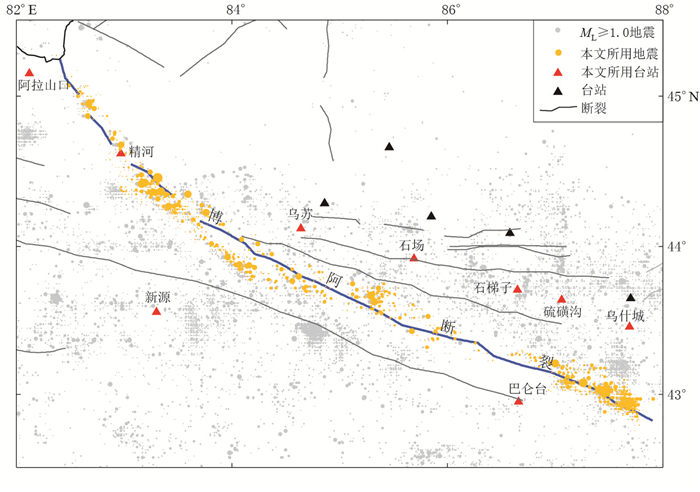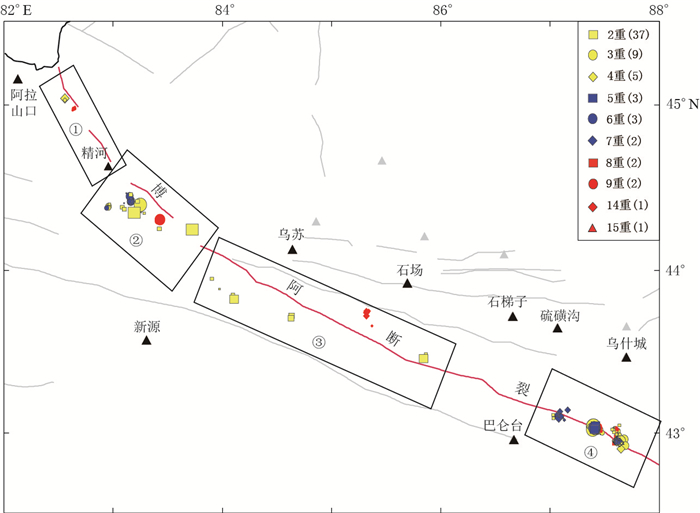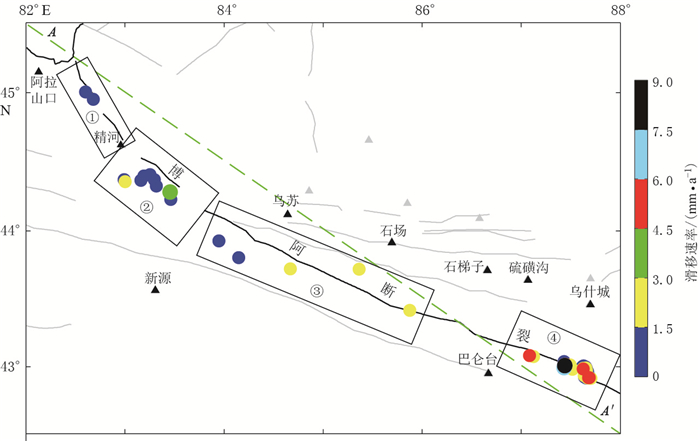Repeating earthquake identification and deep slip rates for western Bolokenu-Aqikekuduke fault
-
摘要: 本文选取博阿断裂西段周围30 km范围内2010年1月—2015年12月期间9个台站记录到的1272次地震事件的波形记录,利用波形互相关技术从中识别出65组(231次)重复地震,并且基于这些重复地震事件估算该断层的滑移速率.结果显示:该区域重复地震比例为18.2%;博阿断裂阿拉山口—精河段、精河—新源段的平均滑移速率分别约为0.99 mm/a和1.35 mm/a,乌苏—石场段、巴仑台—乌什城段的平均滑移速率分别为1.36 mm/a和2.03 mm/a,这与GPS观测结果基本一致;深部滑移速率的极大值分布在2—10 km深度范围内,其中巴仑台—乌什城段在8 km深度处达到了极大值8.6 mm/a.Abstract: In this paper, the waveforms of 1272 earthquake events recorded by nine stations are selected in the western section of the Bolokenu-Aqikekuduke fault around 30 km during 2010-2015. Using cross-correlation analysis of waveforms, we identify 65 groups of repeating earthquakes. The results show that the repeating earthquakes make up 18.2% of total events. Furthermore, we obtain the average slip rate about 0.99 mm/a at the Alashankou-Jinghe section, 1.35 mm/a at the Jinghe-Xinyuan section, 1.36 mm/a at the Usu-Shichang section, and 2.03 mm/a at the Balguntay-Wushicheng section, which is consistent with GPS observations. The maximum deep slip rate appears at the depth ranging from 2 km to 10 km, and the Balguntay-Wushicheng section reaches a maximum of 8.6 mm/a at the depth of 8 km.
-
-
图 1 研究区内地震事件的空间分布及所用台站示意图
灰色实心圆为2010年1月—2015年12月发生的全部ML≥1.0地震; 黄色实心圆为博阿断裂附近30 km内经hypoDD精定位的地震事件
Figure 1. Spatial distribution of earthquake events and the stations used in this studied area
Blue curve represents the Bolokenu-Aqikekuduke fault. Solid triangles represent the stations around the fault, and the red triangles are the stations used in this study. Gray dots represent ML≥1.0 earthquakes during 2010-2015, and yellow dots represent the relocated earthquakes around 30 km of Bolokenu-Aqikekuduke fault by hypoDD method
图 3 重复地震组的空间分布图
黑色方框①—④ 为博阿断裂西段的分段.不同颜色和形状表示不同地震次数构成的重复地震组,图例中括号内为重复地震组个数
Figure 3. Spatial distribution of the repeating earthquake clusters
Black rectangles represent the sections ① to ④ of Bolokenu-Aqikekuduke fault. Different colors and symbols represent the repeating earthquake clusters of different doublets, and the number of repeating earthquake-clusters is given in the legends in the bracket
图 4 断层累积滑动量随时间变化及对应滑移速率
红色圆点为地震事件,黑色虚线的斜率为该重复地震组对应的断层滑移速率,第1个地震事件所对应的断层滑动量为零
Figure 4. The cumulative slip of the fault with time and the corresponding slip rate
Red dots represent the earthquake events. The slope of the black dashed line represents the slip rate corresponding to the repeating earthquake cluster. The fault slip rate of the first event is zero
图 5 博阿断裂西段滑移速率空间分布
绿色虚线AA′为断层走向即深度剖面位置,黑色方框表示博阿断裂西段的分段①—④, 实心圆表示各组重复地震中心点坐标,颜色代表滑移速率大小
Figure 5. Spatial distribution of slip rate for the western Bolokenu-Aqikekuduke fault
Black thick line represents the location of Bolokenu-Aqikekuduke fault, and black rectangles represent the segments ① to ④. Green dashed line AA′ represents the direction of the fault. Colorful dots represent the locations of the repeating earthquake clusters and corresponding slip rates
图 6 博阿断裂西段沿深度剖面AA′的重复地震分布及其滑移速率的深度剖面
红色实心圆为重复地震位置,尺寸大小与震级成正比,“+”表示滑移速率大小
Figure 6. Depth sections showing the locatin of repeating earthquakes and the slip rates along the AA′ for the western Bolokenu-Aqikekuduke fault
Solid red circles represent the locations of repeating earthquakes with size proportional to the magnitude. The symbols "+" represent the slip rates
-
蒋长胜, 吴忠良. 2005.由"重复地震"给出的中国地震台网的定位精度估计[J].中国地震, 21(2): 147-154. http://en.cnki.com.cn/Article_en/CJFDTOTAL-ZGZD200502001.htm Jiang C S, Wu Z L. 2005. Estimating the location accuracy of the China National Seismograph Network using repeating events[J]. Earthquake Research in China, 21(2): 147-154 (in Chinese). http://en.cnki.com.cn/Article_en/CJFDTOTAL-ZGZD200502001.htm
蒋长胜, 吴忠良, 李宇彤. 2008.首都圈地区"重复地震"及其在区域地震台网定位精度评价中的应用[J].地球物理学报, 51(3): 817-827. http://www.oalib.com/paper/1568086 Jiang C S, Wu Z L, Li Y T. 2008. Estimating the location accuracy of the Beijing Capital Digital Seismograph Network using repeating events[J]. Chinese Journal of Geophysics, 51(3): 817-827 (in Chinese). http://www.oalib.com/paper/1568086
李宇彤, 吴忠良, 蒋长胜, 李广平. 2008.利用辽宁区域地震台网记录分析"重复地震"[J].地震学报, 30(4): 383-396. doi: 10.1007%2Fs11589-008-0386-y.pdf Li Y T, Wu Z L, Jiang C S, Li G P. 2008. Analysis on repeating earthquakes recorded by Liaoning Regional Seismograph Network[J]. Acta Seismologica Sinica, 30(4): 383-396 (in Chinese). doi: 10.1007%2Fs11589-008-0386-y.pdf
李乐, 陈棋福, 钮凤林, 付虹, 刘瑞丰, 候燕燕. 2008.利用"重复地震"估算丽江—宁蒗断裂带的深部滑动速率[J].科学通报, 53(23): 2925-2932. doi: 10.3321/j.issn:0023-074X.2008.23.014 Li L, Chen Q F, Niu F L, Fu H, Liu R F, Hou Y Y. 2009. Slip rate along the Lijiang-Ninglang fault zone estimated from repeating microearthquakes[J]. Chinese Science Bulletin, 54(3): 447-455. http://www.oalib.com/paper/1308191
李杰, 陈刚, 魏文薪, 帕尔哈提·再努拉, 王晓强, 刘代芹, 李桂荣, 方伟, 陈述江, 孙小旭. 2016.基于GPS观测的北天山主要断裂现今构造运动特征研究[J].地震学报, 38(5): 751-760. doi: 10.11939/jass.2016.05.009 Li J, Chen G, Wei W X, Paerhati·Zainula, Wang X Q, Liu D Q, Li G R, Fang W, Chen S J, Sun X X. 2016. Characteristics of present-day tectonics movement of typical faults in northern Tianshan mountain deduced from GPS observation[J]. Acta Seismologica Sinica, 38(5): 751-760 (in Chinese). doi: 10.11939/jass.2016.05.009
沈军, 汪一鹏, 李莹甄, 姜慧, 向志勇. 2003.中国新疆天山博阿断裂晚第四纪右旋走滑运动特征[J].地震地质, 25(2): 183-194. https://www.researchgate.net/publication/289108962_Late_Quaternary_activity_of_Jinghe-Alashankou_section_of_the_Boluokenu_fault_interior_Tianshan Shen J, Wang Y P, Li Y Z, Jiang H, Xiang Z Y. 2003. Late Quaternary right-lateral strike-slip faulting along the Bolokenu-Aqikekuduke fault in Chinese Tian Shan[J]. Seismology and Geology, 25(2): 183-194 (in Chinese). https://www.researchgate.net/publication/289108962_Late_Quaternary_activity_of_Jinghe-Alashankou_section_of_the_Boluokenu_fault_interior_Tianshan
杨晓平, 沈军. 2000.天山内部博罗可努断裂精河—阿拉山口段晚更新世以来的活动特征[J].地震地质, 22(3): 305-315. https://www.researchgate.net/publication/289108962_Late_Quaternary_activity_of_Jinghe-Alashankou_section_of_the_Boluokenu_fault_interior_Tianshan Yang X P, Shen J. 2000. Late Quaternary activity of Jinghe-Alashankou section of the Boluokenu fault, interior Tian-shan[J]. Seismology and Geology, 22(3): 305-315 (in Chinese). https://www.researchgate.net/publication/289108962_Late_Quaternary_activity_of_Jinghe-Alashankou_section_of_the_Boluokenu_fault_interior_Tianshan
杨晓平, 邓起东, 张培震, 徐锡伟. 2008.天山山前主要推覆构造区的地壳缩短[J].地震地质, 30(1): 111-131. http://en.cnki.com.cn/Article_en/CJFDTOTAL-DZDZ200801008.htm Yang X P, Deng Q D, Zhang P Z, Xu X W. 2008. Crustal shortening of major nappe structures on the front margins of the Tianshan[J]. Seismology and Geology, 30(1): 111-131 (in Chinese). http://en.cnki.com.cn/Article_en/CJFDTOTAL-DZDZ200801008.htm
Båth M. 1974. Spectral Analysis in Geophysics[M]. Amsterdam: Elsevier Scientific Publishing Company: 87-94.
Chen K H, Nadeau R M, Rau R J. 2008. Characteristic repeating earthquakes in an arc-continent collision boundary zone: The Chihshang fault of eastern Taiwan[J]. Earth Planet Sci Lett, 276(3/4): 262-272. http://www.academia.edu/6137538/Characteristic_repeating_earthquakes_in_an_arc-continent_collision_boundary_zone_The_Chihshang_fault_of_eastern_Taiwan
Han L B, Wu Z L, Li Y T, Jiang C S. 2014. Cross-correlation coefficients for the study of repeating earthquakes: An investigation of two empirical assumptions/conventions in seismological interpretation practice[J]. Pure Appl Geophys, 171(3/4/5): 425-437. https://www.researchgate.net/publication/257317632_Cross-correlation_Coefficients_for_the_Study_of_Repeating_Earthquakes_An_Investigation_of_Two_Empirical_AssumptionsConventions_in_Seismological_Interpretation_Practice
Hanks T C, Kanamori H. 1979. A moment magnitude scale[J]. J Geophys Res, 84(B5): 2348-2350. doi: 10.1029/JB084iB05p02348
Li L, Chen Q F, Cheng X, Niu F L. 2007. Spatial clustering and repeating of seismic events observed along the 1976 Tangshan fault, north China[J]. Geophys Res Lett, 34(23): L23309. doi: 10.1029/2007GL031594.
Li L, Chen Q F, Cheng X, Niu F L, Su J R. 2011. Deep slip rates along the Longmen Shan fault zone estimated from repeating microearthquakes[J]. J Geophys Res, 116(B9): B09310. doi: 10.1029/2011JB008406.
Luo Y, Schuster G T. 1991. Wave-equation travel-time inversion[J]. Geophysics, 56(5): 645-653. doi: 10.1190/1.1443081
Marquering H, Dahlen F A, Nolet G. 1999. Three dimensional sensitivity kernels for finite-frequency traveltimes: The banana-doughnut paradox[J]. Geophys J Int, 137(3): 805-815. doi: 10.1046/j.1365-246x.1999.00837.x
Matsuzawa T, Igarashi T, Hasegawa A. 2002. Characteristic small-earthquake sequence off Sanriku, northeastern Honshu, Japan[J]. Geophys Res Lett, 29(11): 38-1-38-4. doi: 10.1029/2001GL014632.
Matsuzawa T, Uchida N, Igarashi T, Okada T, Hasegawa A. 2004. Repeating earthquakes and quasi-static slip on the plate boundary east off northern Honshu, Japan[J]. Earth Planets Space, 56: 803-811. doi: 10.1186/BF03353087.
Nadeau R M, McEvilly T V. 1999. Fault slip rates at depth from recurrence intervals of repeating microearthquakes[J]. Science, 285(5428): 718-721. doi: 10.1126/science.285.5428.718
Poupinet G, Ellsworth W L, Frechet J. 1984. Monitoring velocity variations in the crust using earthquake doublets: An application to the Calaveras fault, California[J]. J Geophys Res, 89(B7): 5719-5731. doi: 10.1029/JB089iB07p05719
Rubin A M. 2002. Using repeating earthquakes to correct high-precision earthquake catalogs for time-dependent station delays[J]. Bull Seismol Soc Am, 92(5): 1647-1659. doi: 10.1785/0120010180
Schaff D P, Beroza G C. 2004. Coseismic and postseismic velocity changes measured by repeating earthquakes[J]. J Geophys Res, 109(B10): B10302. doi: 10.1029/2004JB003011.
Schaff D P, Waldhauser F. 2005. Waveform cross-correlation-based differential travel-time measurements at the Northern California Seismic Network[J]. Bull Seismol Soc Am, 95(6): 2446-2461. doi: 10.1785/0120040221





 下载:
下载:





